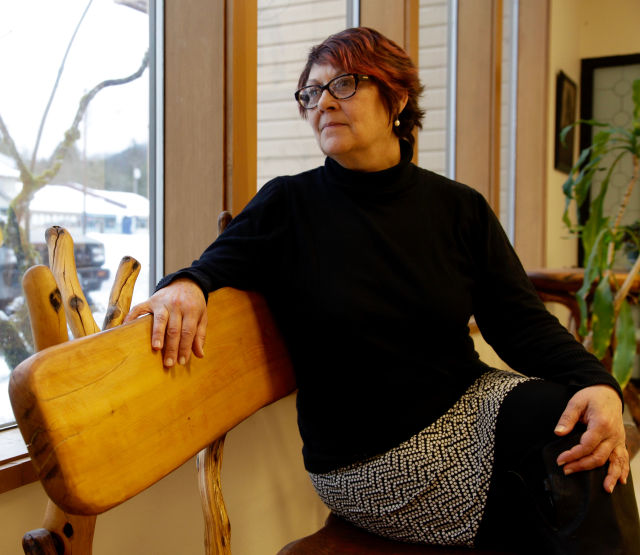In Rural Oregon, Victims of Domestic Violence Face Huge Barriers

When Christine, a resident of Cave Junction, was punched repeatedly in February by her drunken estranged husband, she could count herself lucky.
It took an Oregon State Police trooper more than 40 minutes to arrive, but at least someone responded—more help than domestic and sexual violence victims often get in this rural part of Oregon, just 20 miles north of the California border.
But while Christine, whose last name is withheld for her safety, ended up at the hospital with a concussion and bloody bruises, the trooper didn’t file a police report. OSP took the estranged husband to a sobriety center instead of jail. And with the Josephine County courthouse closed for the weekend, Christine couldn’t file for a restraining order.
Her husband was released the next day. He broke into Christine’s house and waited with the lights off. Fortunately, her friends and family found him first.
“Sitting in the hospital, I thought, ‘How can a woman ever go back to a man like that?’” Christine says. “But when you don’t have the help to feel you can stand strong, if you don’t have a support system, you almost don’t have a choice.”
In rural Oregon, that support system has been lacking for years. “Rural women have a hugely difficult time accessing help,” says Emily Evans, executive director of the Women’s Foundation of Oregon. “Cave Junction [shows] how communities have catastrophically underinvested in their capacity to support survivors.”
Cave Junction, with a population just under 2,000, lies a 40-mile drive down two-lane Redwood Highway from the Josephine County seat, Grants Pass. The timber industry’s decline has left tourism and, increasingly, cannabis cultivation as the economic staples. The area is a mix of loggers, hippies, artists, retirees, marijuana growers, and so-called trimmigrants, who come in search of marijuana harvest jobs.
The tiny city, “Gateway to the Oregon Caves”—where a few restaurants, gas stations, and liquor and thrift stores cluster along the main drag—has limited social services. People living outside town often have few neighbors, spotty phone reception, and no access to public transportation, says Susie Ellwood, executive director of the Cave Junction–based Illinois Valley Safe House Alliance (named for the Rogue River tributary that runs through town). To escape batterers, Ellwood says survivors sometimes must walk for miles, hiding in ditches.

Susie Ellwood of the Illinois Valley Safe House Alliance
Image: Gosia Wozniacka
Ellwood’s group provides everything from advocacy and assistance with restraining orders to clothing and emotional support. “We hope to help the victim see how they came to be where they are,” she says. “Maybe nobody has taken the time to say they’re important, that they’re worth saving.”
The nearest safe shelter is 40 minutes away, in Grants Pass. Usually, it’s full. Shelters in other rural counties are also at capacity. Long-term affordable housing is hard to find, Ellwood says. And economic opportunities are slim. The area has a poverty rate of about 30 percent.
Those who do find a safe place may have trouble getting there. There’s no local Greyhound station, and the county bus that runs on weekdays uses an exposed stop on the main street, meaning an abuser can easily spot someone fleeing by bus.
The alliance has seen its clientele rise over the past five years. Its budget is stretched thin from paying for emergency motel stays and food.
But the biggest challenge? Lack of law enforcement. Timber revenues nose-dived in the ’90s, gutting county budgets across rural Oregon, and federal stop-gap funding has declined over the past decade. In 2012, Josephine County sheriff’s deputy patrols dwindled to eight hours on weekdays. The jail released dozens of inmates. Most people charged with crimes received tickets or citations.
In the Cave Junction area, break-ins occurred almost daily after the cuts in coverage: at the local library, high school, coffee shops, churches, thrift stores. Yet the county’s voters rejected five successive public safety levies. The alliance saw a significant drop in women seeking help to file restraining orders—there was no one to enforce them.
In a 911 call from 2012 that made national news, a Cave Junction woman told Oregon State Police her ex-boyfriend was trying to break into her house. After being told no one was available to respond, she was beaten and raped. Following the incident, the sheriff’s office issued a press release suggesting domestic abuse victims “consider relocating to an area with adequate law enforcement services.”
Last May, with deeper cuts looming, voters OK’ed a tax increase. Since then, Sheriff Dave Daniel has hired 20 new employees. Most of the new corrections staff are still in training, including three resident deputies who will live in the communities they serve. “Due to the geographic layout of our county and the distances, response may take more time,” Daniel says. “But those responsible will be held accountable.”
As a small sign of improvement, victims are again filing for restraining orders. “They have more faith now that they’ll be enforced,” Ellwood says.
Meanwhile, a local organization has turned part of its attention to young people. The Women’s Crisis Support Team, which also runs the county’s safe shelter and crisis line, teaches freshmen at area high schools—though not yet in Cave Junction—about healthy relationships and early signs of dating violence. In an elective class, students dig deeper into power, control, and consent. Youth-led action teams have also picketed on a Grants Pass bridge with signs reading “No Means No” and traveled to Salem to speak to legislators about domestic violence.
“The youth get it,” says Krisanna Albrecht, the support team’s executive director. “They want change, they want to be different, they want a safe and healthy community. They’re sometimes the best advocates for change and to drive policy, because they’ll be the ones living it.”

















